“Remember the Dead, Fight For the Living”
Interview with labour activist Taslima Akhter on garment workers’ struggles in ten years since the Rana Plaza tragedy.
Siraj Uddin (40) and Majeda Khatun (35), parents of New Wave Style factory worker Shirin (18), found their beloved daughter's dead body in the morgue after 12 days since the collapse of Rana Plaza. Dhaka Medical College Hospital, Dhaka, Bangladesh. 5th May 2013. Image: Taslima Akhter
From the ruins of the Rana Plaza collapse in 2013 arose a renewed struggle for workers’ rights, better wages and safer working conditions. Over the past ten years, the readymade garment industry (RMG) in Bangladesh has seen significant workers’ protests and movements, with the mushrooming and strengthening of a number of trade unions and workers’ collectives. One such organisation, which has led these struggles for change, has been the Bangladesh Garment Workers Solidarity (BGWS), formed in 2008. Once the dust settled from the Rana Plaza tragedy and the international gaze shifted, the multinational brands, local factory owners, as well as the state, went back to the exploitative conditions across the thousands of factories in Bangladesh. However, BGWS, along with organisations such as the Garment Workers Trade Union Centre and other collectives like the Garment Workers’ Rights Movement (comprising 10 member organisations), have ensured that workers’ struggles for better wages and safer working conditions continued.
To understand how these struggles have evolved post-Rana Plaza, and the many challenges that unions and workers have had to navigate, Pratim Ghosal spoke to Taslima Akhter, the acting president and founder member of the Bangladesh Garment Sramik Samhati (BGWS). Taslima is also a Magnum Fellow and an award-winning photojournalist, whose photo, the “Final Embrace,” emerged as a haunting spectre of loss and exploitation of the global RMG industry to the world. She has been a part of the struggle for workers’ rights for the last 15 years; she edited a 480-page book in Bangla on the Rana Plaza collapse called Chobbishe April: Hazar Praner Chitkar (24th April: Outcries of Thousand Souls). Taslima also served in an editorial role for the website www.athousandcries.org and coordinated the Memorial Quilt project as part of her work with the community. In addition to her activism, Taslima has written numerous articles on women's and workers' issues and has translated Alexandra Kollontai's writings. She currently teaches at the Pathshala South Asian Media Institute. To learn more about her, please visit her website.
Taslima Akhter, acting President and founder of Bangladesh Garment Worker Solidarity. Image: Mengwen Cao (provided by Akhter)
In this conversation, Taslima reflects on the RMG workers’ struggles over the last decade, the specific challenges of NGO-ization and transnational solidarities, and the current situation in the readymade garment industry in the wake of the COVID-19 pandemic and ongoing economic crisis. She also tells us how Rana Plaza is remembered in the popular memory of the workers and how it serves a reminder to one and all, “to remember the dead, fight for the living.”
Pratim Ghosal (PG): We would like to start this interview by asking you about the workers who lost their lives, went missing, or continue to suffer from the trauma of the Rana Plaza massacre. Can you tell us about them: who they were/are, where they come from, and how their lives continue to be impacted by that fateful day?
Taslima Akhter (TA): Once upon a time, I could recognize the names of many dead workers if I saw their photos. I could also remember the real-life stories for many of them. Now, after ten years of the Rana Plaza killings, I don’t remember all the details. However, I am still haunted by the cruel history and terrifying emotions — every year on April 24th, those memories return. At that time, we had compiled a list of the unidentified deceased, and learned about the workers who lost their lives through their families' stories. Those once-unknown individuals gradually became familiar and close to us. Their lives and struggles are now documented in Chobbishe April: Hazar Praner Chitkar (24th April: Outcries of Thousand Souls), where they come alive and raise their voices for justice. I still struggle to believe the terrifying cruelty I witnessed.
I remember Sagarika, Shahina, Saudat, Brajeshwar, and many others. In 2013, at the age of 17, Sagarika left her village in Natore district with her family to escape debt and started working at Ethertext Garments in Rana Plaza. She had dreams of repaying her parents' debts, educating herself and her younger sister, and building a sturdy brick house in their village. Tragically, she passed away before realising her dreams. I also remember Shahina's story. After five long days of rescue efforts, she was found trapped 78 feet deep in the debris. Her ordeal was broadcasted live on TV. Shahina's heartfelt desire was to see her one-and-a-half-year-old son, Robin. But during the rescue operation, a sudden fire broke out, and Shahina lost her life. Shahina, the girl from the riverbank, had aspirations of living a better life with her fisherman father, housewife mother, and other loved ones in the Potukhali district.
“...the Rana Plaza factory employed workers from 59 out of 64 districts in Bangladesh. Among them, 57.58% were between the ages of 18 and 25, and even children aged 13 to 17 were employed. Nearly 60% of the workforce were women ...”
Similarly, thousands of dead workers like Sagarika or Shahina, who lived in villages without owning any land, came to work at Rana Plaza, hoping for a better and new life with a monthly wage of only 3,000 takas. In fact, the Rana Plaza factory employed workers from 59 out of 64 districts in Bangladesh. Among them, 57.58% were between the ages of 18 and 25, and even children aged 13 to 17 were employed. Nearly 60% of the workforce were women — all of their lives and dreams ruined under the rubble.
Among all rescuers, I cannot forget two of them — Manik, a RMG worker, and Himaloy Himu, an organiser from the Bangladesh Student Federation. Manik is still suffering from mental trauma, and unfortunately, Himu, the best rescuer on our team, committed suicide on April 24th, 2019, due to trauma and depression.
PG: Can you tell us briefly about the history of organising amongst the garment workers, a majority of whom are women? How did the Rana Plaza incident affect the workers’ movement in terms of tactics and issues raised?
TA: Among 4 million garment workers in Bangladesh, 60% are women. Many of these young women come from rural areas and have stepped beyond the boundaries of their homes. This important coming together of politics, economy, and gender issues has captured my interest since my student days. It also fueled my aspiration to engage in workers' politics. In 2008, a group of friends and I founded the Bangladesh Garment Workers Solidarity (BGWS), comprising members from both workers and the middle-class. Our goal has been to ensure workers' rights and establish real trade unions. Establishing a genuine or real trade union movement is a hard task, particularly in Bangladesh, where trade union politics are heavily influenced by the close ties between owners and the government. Unfortunately, many organisations operating as trade unions are considered "yellow/paper unions" that do not genuinely serve the interests of workers.
On the other hand, we aimed to create leadership based on ideals, and emphasize women's leadership as well. My experience in student politics, photography and my identity as a woman — all these components have helped me establish close relations, especially with women workers and organise both male and female workers. Although the female identity is always not favoured in activism, we need to address the issue at hand. Yet, female workers still face gender discrimination, both within and outside the home. This social and state discrimination limits their opportunities for leadership roles.
Wherever there was a movement, we made an effort to be present. We initiated our work in major industrial zones — organising the workers, fighting for their rights, acting as pressure groups, engaging in discussions, conducting training sessions, workshops, publications, and integrating our lives became our crucial tasks. In the realm of organizing women workers, we played a significant role in advocating for maternity leave, demanding a fear-free environment regarding sexual harassment, calling for childcare facilities, addressing various family issues, and creating a space for them to come together during both challenging and joyful moments. We don’t only emphasise female leadership; we also address gender issues within BGWS practices — our constitution includes a sexual harassment policy as well.
Until the Rana Plaza incident, wages, trade unions, and democratic labour laws were the three primary concerns of the labour movement. After the collapse, the issue of safety has taken centre stage. Along with building construction and the amount of compensation, questions regarding the punishment of the culprits have also emerged. Simultaneously, the question of responsibility and accountability of the owner-buyer and the government in ensuring the safety of workers' lives has become evident. Although owner-buyers are now compelled to talk more about ensuring workers' rights, the number of trade unions has increased on paper more than in reality. After the Rana Plaza incident, the most important demand has been, "Remember the dead, fight for the living," which encompasses the lives of the young workers currently employed in this sector. It emphasises the development of their livelihoods beyond just building construction, including wages, dignity, and civil rights as well.
Mother grieves as she lies besides a photograph of her daughter Poly Akther, a garment factory worker who lost her life in the Rana Plaza collapse. Image: Taslima Akhter
PG: In the aftermath of the collapse, The Accord on Building and Fire Safety was established — a tripartite, binding agreement between 200 global brands and retailers, the garment and knitwear manufacturers, and global trade unions covering the working conditions in over 1600 factories. Has the Accord made a difference for the workers, on the ground? If not, why?
TA: After 2013, international brands responded to consumer pressure by working on factory building safety in Bangladesh and initiating the Accord and the Alliance (the Alliance for Bangladesh Workers Safety, led by mostly American brands). Progress has been made, with the Accord completing 92% of remediation work in almost 1,600 factories by 2020. However, fire alarm systems were still lacking in the remaining 1,333 factories. Despite the National Tripartite Plan of Action (NTPA) being in effect, it hasn't sufficiently demonstrated national capability. The RMG Sustainability Council (RSC) is currently progressing slowly, with accountability for the legal process generally unknown. Undoubtedly, achieving national capability is crucial in facing the existing crises and finding solutions.
When the Rana Plaza collapse occurred in 2013, it was an emergency. Bangladeshi people and international consumers all showed great concern for the trapped workers and provided significant support. The Accord alliance also entered that time in Bangladesh to protect their “image” in the global market. But, these brands are also responsible for the workers' dire situation. They cannot solely blame local owners; they prioritise global capital interests and take most of the profits. The Accord initiative cannot be an excuse for them. They must take responsibility for the workers' well-being, along with the local owners and government.
In the past decade, though fire incidents have occurred in other sectors, major incidents like Rana Plaza or Tazreen haven't been observed in the garment industry. The textile industry has gained recognition, with owners aiming to transform it into a $100 billion sector by 2030, focusing on green and eco-friendly factories in Bangladesh. But in the last ten years, those responsible for over 1,100 worker deaths — building owners, factory owners, government officials, foreign buyers — haven't faced proper legal proceedings. While progress has been made in building development, business growth, and increased profits, there hasn't been proportional improvement in workers' wages or benefits. Hence, improving workers' lives requires searching within the realm of their livelihoods, not just within the concrete structures.
PG: In particular, the issue of NGO-ization of the trade union movement has also emerged, especially in the post-2013 context. How do you view this issue, and the role of BGWS in this context?
TA: After the Rana Plaza collapse, many NGOs have emerged, providing training in various skills and rehabilitation programs for the affected individuals. However, they have not shown the same level of commitment in holding the state and factory owners accountable for fulfilling compensation promises and bringing the perpetrators to justice. Instead, workers' dignity and consciousness are undermined as they rely on charity and seek assistance door-to-door.
“It (workers’ movement) is about the struggle for dignity, livelihood, and the rights of workers as citizens. The workers’ movement should be driven by ideological motivation and collective leadership working in the workers’ interests”
Since 2013, some renowned NGOs have started focusing more on workers' issues, conducting research and training, focusing on gender issues and legal support. Sometimes, the NGO’s research data and analysis on RMG workers have helped us. But, some of their collaboration with the government, owners and brands limits their ability to expose the full extent of the workers' suffering. NGOs’ work are highly dependent on international donors and foreign funds that create a distance and alienation with the grassroots. We also think that this kind of funding dependency can’t create accountability and build relations with local people. NGO programs primarily encourage workers to pursue legal actions rather than engaging in movements. Moreover, NGOs sometimes offer glamorous visions of a better life for organisers through training programs that include luxurious venues, food, and other benefits. But we believe that the workers' movement is not about luxury, nor any shortcut path or personal gain. It is about the struggle for dignity, livelihood, and the rights of workers as citizens. The workers' movement should be driven by ideological motivation and collective leadership working in the workers' interests.
We firmly believe that it is not by charity but through united struggle that we can prevent another Rana Plaza disaster, exert pressure on the government, owners, and brands, and ensure just reparations, fair wages, and the right to unionise. Struggle, unity, and solidarity at the local and global levels are essential to defend workers' dignity, transform grief into strength, and fight for their rights.
“Final Embrace”: two workers amidst the rubble of the garment factory collapse at Rana Plaza. They tried to save each other in the last moments of their lives. About 1175 workers died and several hundred were missing from this eight-story building. Savar, Dhaka, Bangladesh. 25th April 2013. Image: Taslima Akhter.
PG: In recent years, the COVID-19 pandemic or the recent power outages have once again highlighted how workers are treated as disposable, as you have written in your article. How have these multiple crises over the last few years shaped working conditions, and how have workers and trade unions responded?
TA: After the Rana Plaza collapse, survivors and families faced constant turmoil, with no respite to remember their loved ones in peace. Amid the pandemic, social distancing and health issues became a luxury, as young workers were forced to sacrifice their well-being for the economy. They even had to take to the streets frequently to demand the reopening of closed factories, or to claim their dues. In the current context of inflation, the struggle for a living wage has become even more challenging for workers. But throughout this period, instead of getting incentives or higher minimum wages, they were haunted by fears of losing jobs and being tortured.
Every time owners and buyers have benefited from crises (the Rana plaza collapse, the COVID-19 pandemic, Russia-Ukraine war’s impact on the global economy, inflation, etc), the workers couldn’t. As owners thrive, workers' living standards decline, and their children suffer. RMG workers are always asked to shoulder any losses incurred, but when owners are inundated with profits, workers do not get their fair share. Profits are personal, but losses are social – this neoliberal economic trend can be seen in the garments sector of Bangladesh too.
Currently, garment workers are demanding a monthly wage of 25,000 taka (USD $233.26 at current exchange rate) instead of the current monthly wage of 8000 taka (~ USD $75). They are also demanding their right to organise and achieve a national minimum wage.
We, the BGWS and our allies, the Garment Workers Rights Movement (comprising 10 organisations) and the Garment Workers Trade Union Centre, have been working together for a long time to establish a new wage board and declare a higher minimum wage. Finally, last month, the government formed a wage board. Now, our collective effort is focused on unifying the movement. Throughout history, we have observed deliberate attempts by governments and owners to thwart united movements. However, we remain committed to advancing unity. To raise awareness and build support, we have organised gatherings and protests in various worker areas. We have also engaged in discussions with other groups, including economists, intellectuals, researchers, and womens’ rights organisations, to shape public opinion in favour of a minimum wage of 25,000 taka ($233.26). As well, we have submitted memoranda to the Bangladesh Garment Manufacturers and Exporters Association (BGMEA; the owners’ trade association) and at the inaugural meeting of the wage board. We are also considering conducting research on the daily living expenses of workers and the overall development of the garment sector, including the situation of owners, during this time of inflation.
Recognizing the critical political climate, we believe it is essential to hold not only owners, but also the government accountable for the well-being of workers. Moreover, as this sector is part of the global supply chain, we believe it is crucial to engage buyers and demand accountability from their end as well.
We firmly believe in the strength of workers within their local reality, and we are fully committed to organising them. There is a prevailing environment of fear, a lack of workers’ democracy, and a lack of proper voting rights in the country. Political representation, democracy, and accountability are also essential for workers to exercise their rights.
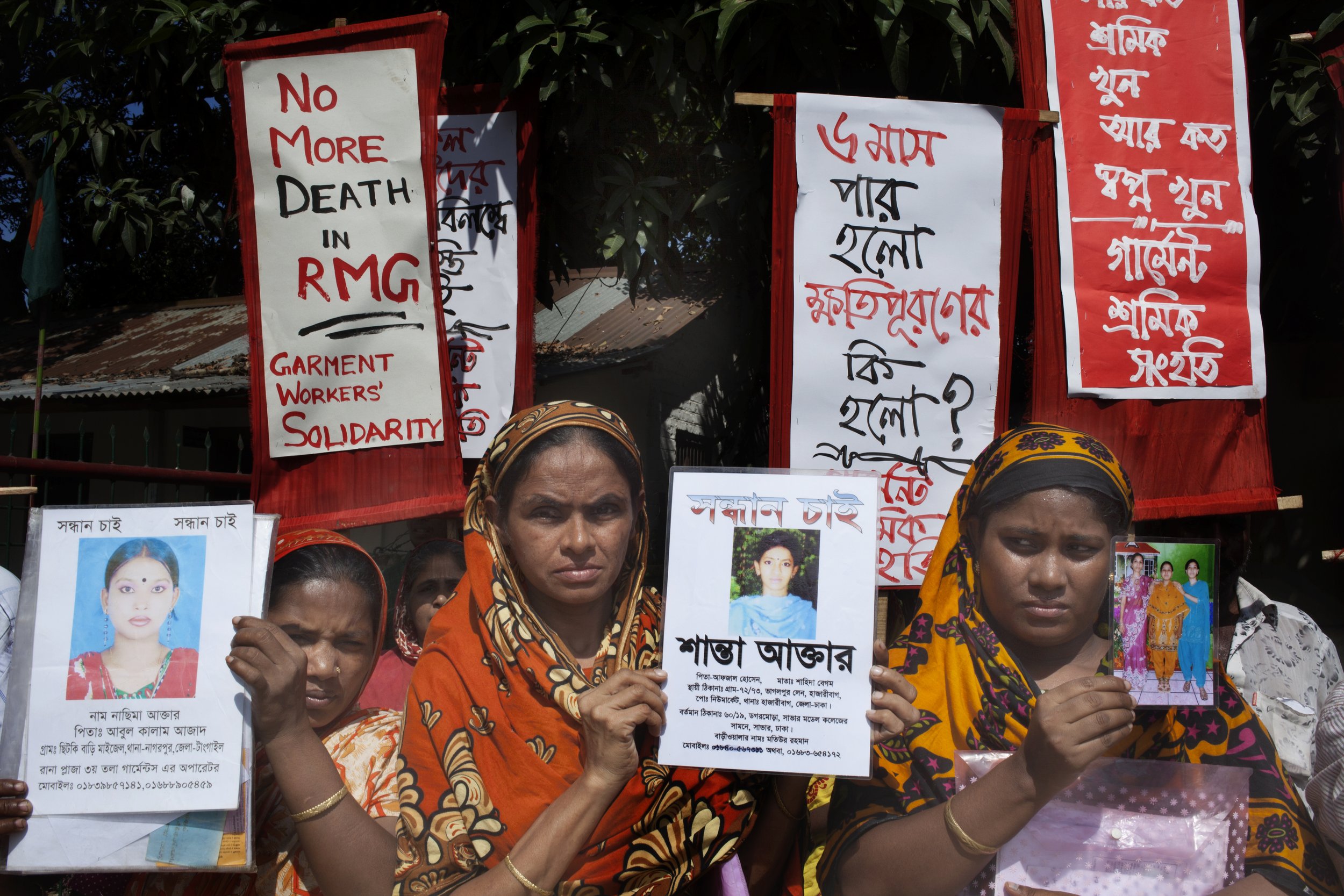

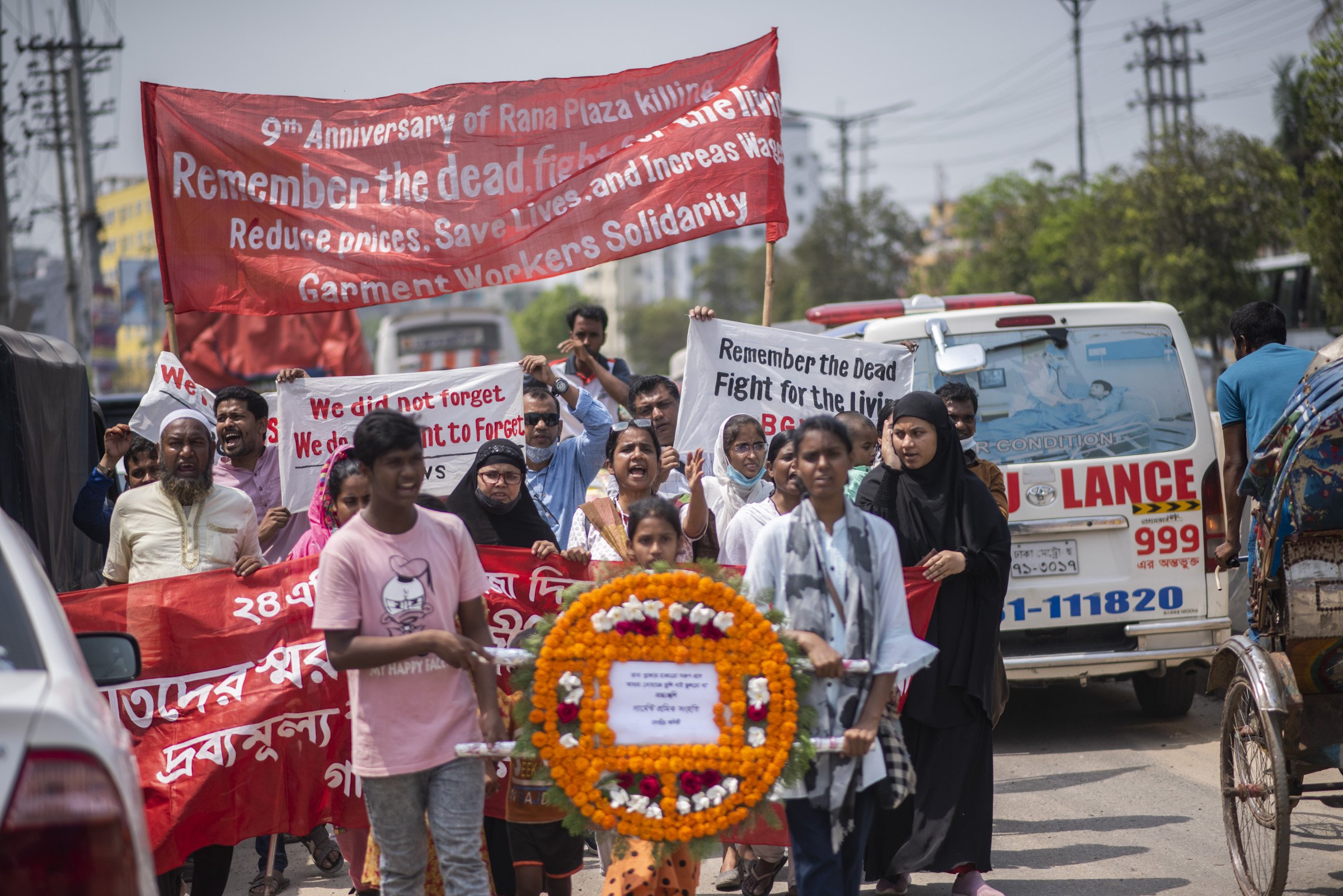
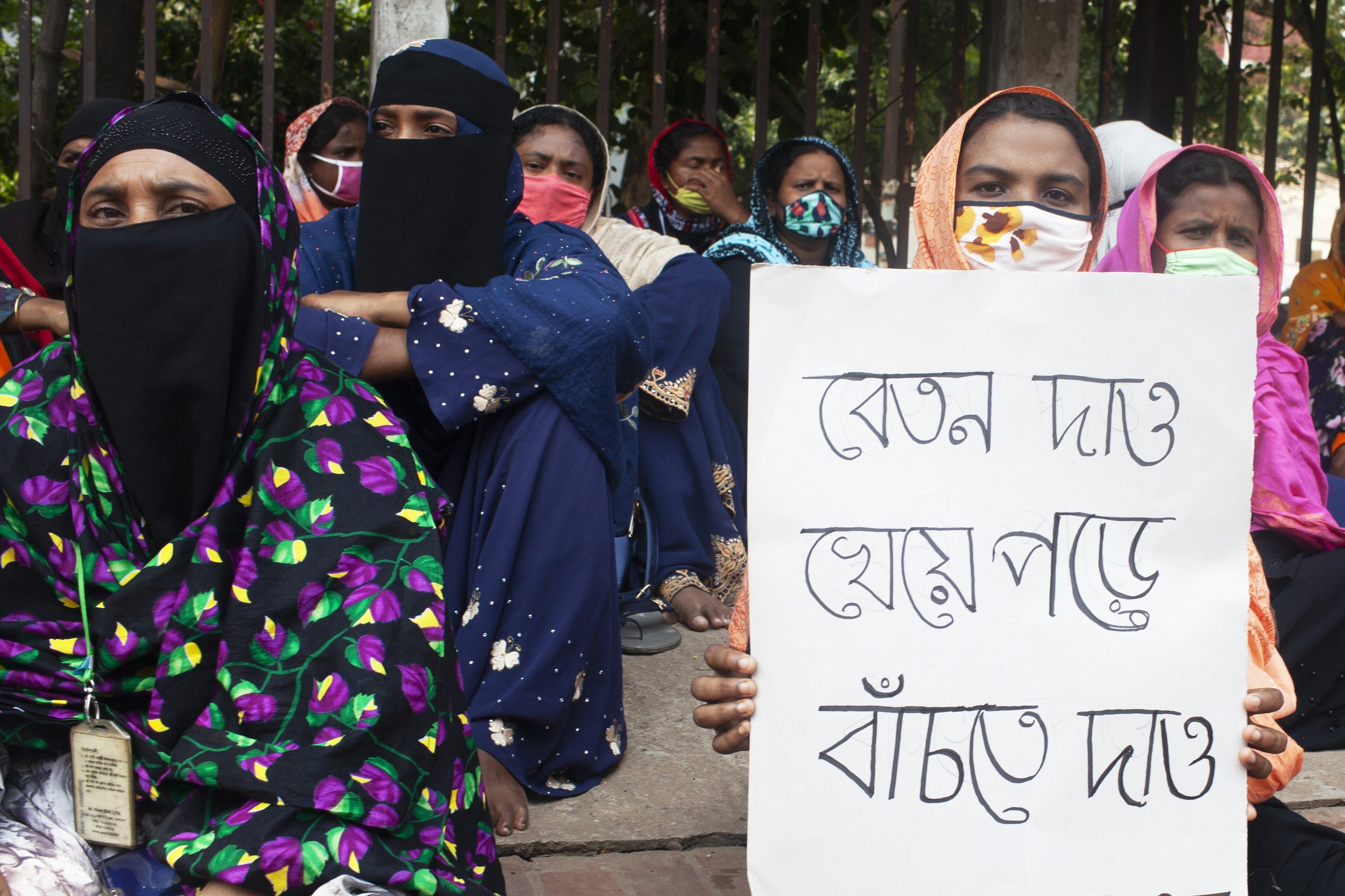
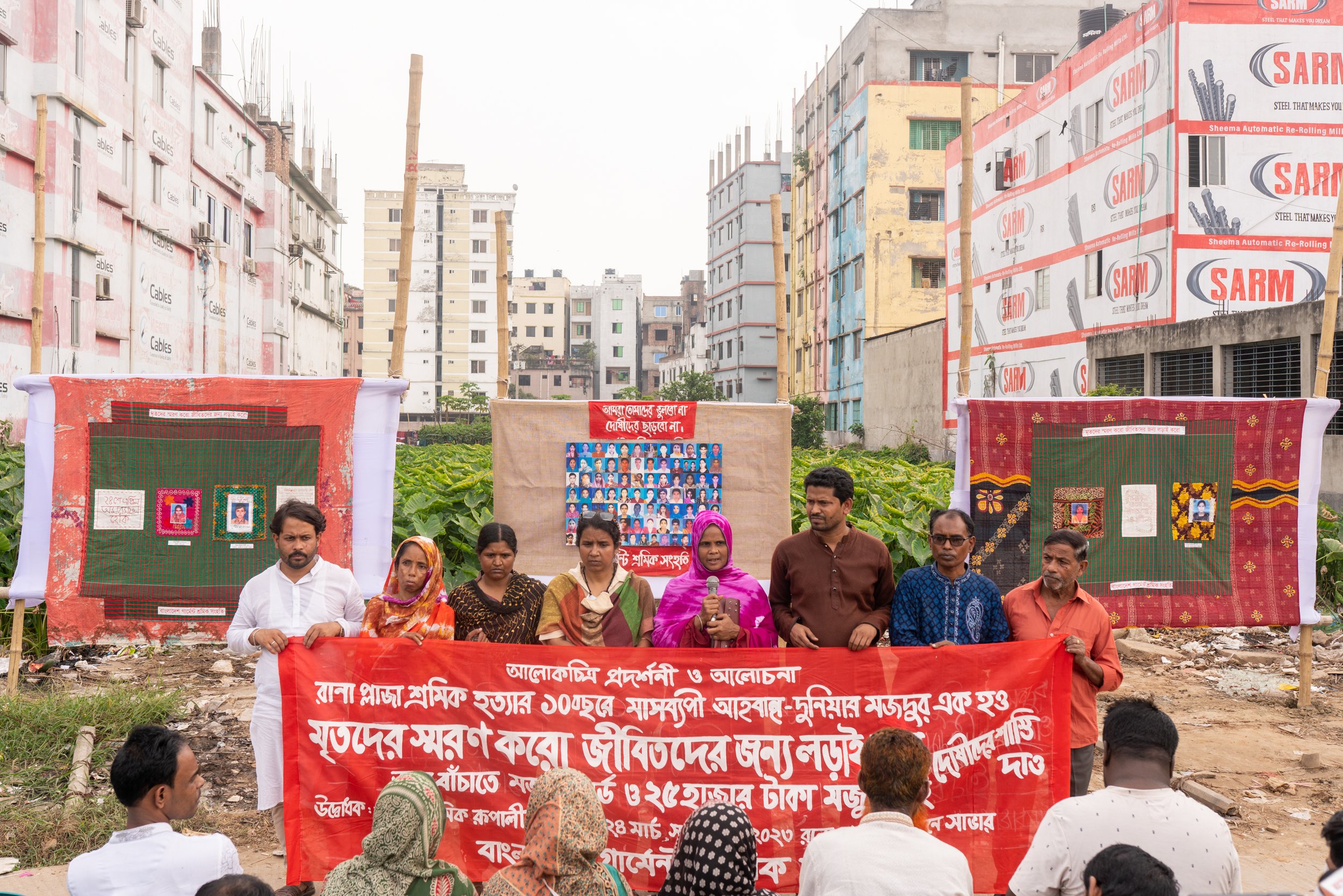
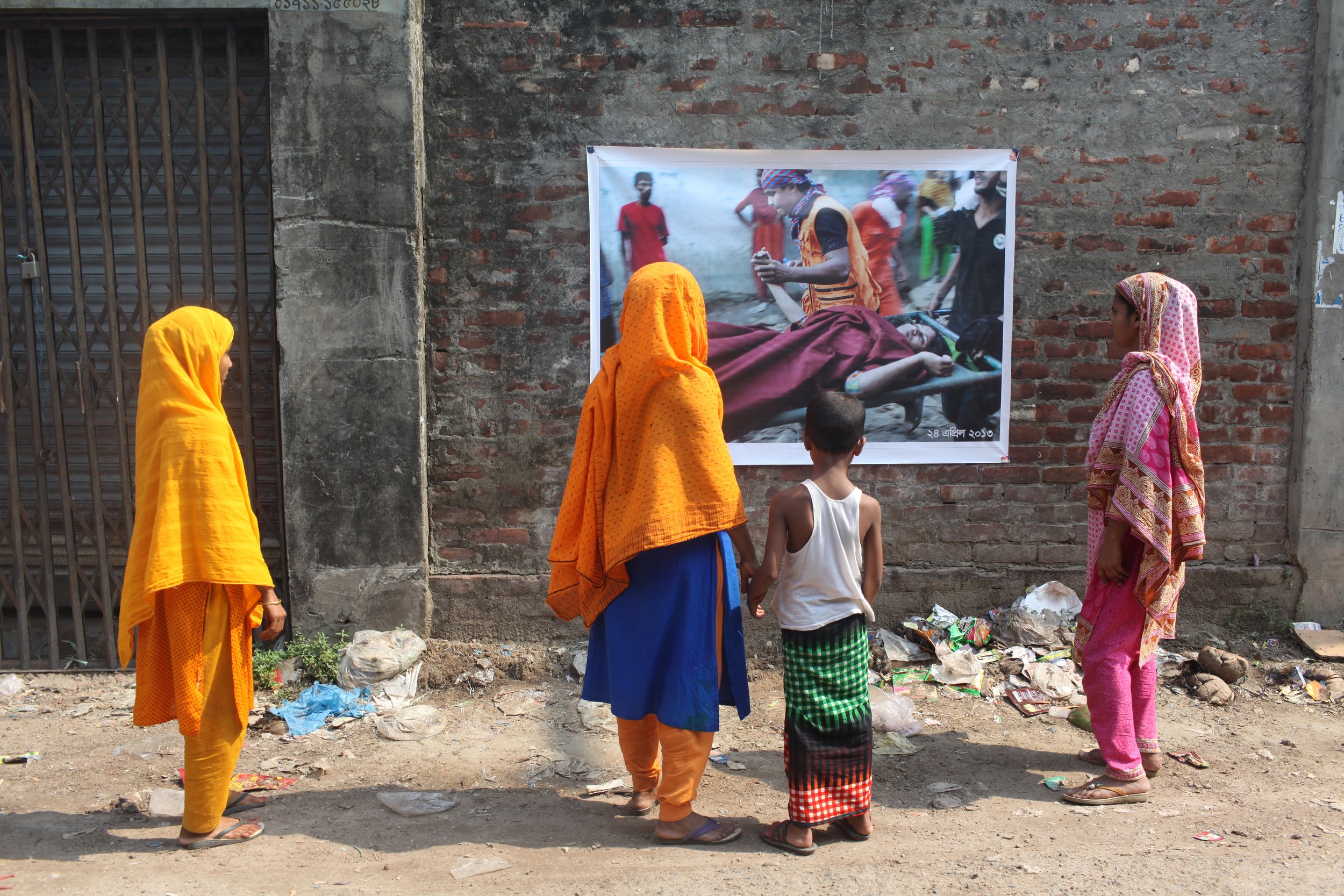
PG: Before we end, I would like to focus on the powerful work that you do through your documentary photography. How important is this aspect — of documenting the life and struggles of workers — within the wider struggles of trade union organising?
TA: A movement thrives through the synergy of struggle and cultural activity that gives momentum to the fight. Photography is one of my tools for struggle. Through capturing moments, photography evokes emotions and creates a profound connection with the viewer. It conveys messages that energises the fight to change the status quo. Embracing new methods like photography alongside traditional activism is essential. It preserves the labour movement's history.
“Through capturing moments, photography evokes emotions and creates a profound connection with the viewer. It conveys messages that energises the fight to change the status quo.”
In 2010, in support of the wage movement, my first solo exhibition on garment workers was exhibited at Drik Gallery. Apart from this, pictures of daily life of workers, insecurity of Rana Plaza and Tazreen, struggles during the pandemic, the wage movement and other work on RMG workers have been displayed at various places and published. Until 2023, these photographs have also been displayed in several working-class areas in Savar, Ashulia, and Narayanganj. The primary aim of exhibiting these in labour areas was to return to the community and engage them in dialogue, establish connections, and contribute to the local movement. Most of my photography and other photographers’ works on garment workers have been exhibited in the local community by the BGWS.
Apart from this, the main aim of various galleries inside or exhibitions outside the country was to create the support of the people, the middle class and the consumers towards the labour movement. Another aim is questioning owner-buyer and government accountability. Apart from me, many other photographers who have worked on the life and safety of garment workers have also tried to increase solidarity in the struggle by bringing that work together in exhibitions.
The BGWS initiative has actively involved workers and their families in creative endeavours. As part of this effort, a memorial quilt called "Smriti Kantha" was created by the families of the deceased and injured workers of Rana Plaza, incorporating pictures, words, and stitches. BGWS also plays a crucial role in collecting photographs of the missing workers from Rana Plaza and utilising them in publications. These initiatives highlight the strengths of the trade union movement. Films, paintings, music, novels, and various forms of art and literature can also contribute to the cultural struggle, providing further strength to the garment workers' movement. The inclusion of such cultural expressions in the workers' movement is eagerly needed.
PG: And finally, can you tell us how workers have memorialised Rana Plaza in their popular history and struggles?
TA: The Rana Plaza murder is one of the largest incidents in industrial history with global implications for workers’ history. Every year, labour organisations in Bangladesh commemorate this day, often with protests in front of the Rana Plaza site. As part of the BGWS, we protested in front of Rana Plaza on or around the 24th of every month from 2013 to 2020. Of course, this was not possible once the Covid-19 pandemic started. This year, however, along with protest rallies and tributes, photo exhibitions, publications, discussions, gatherings and children's drawings were organised so that this day is not forgotten.
The BGWS observed this day with a month-long program to preserve the history of Rana Plaza, to demand the punishment of the culprits and changes in the compensation law, and to advocate for 25,000 taka wages for the living workers, along with making other demands. At the same time, we have called upon the whole world to observe 24th April to demand workers’ safety globally. We must all say in unison, “Remember the dead, fight for the living — workers of the world unite!” This year, on its 10th anniversary, many countries outside Bangladesh have commemorated Rana Plaza Day in order to emphasise the importance of global workers’ safety, fair wages and trade union rights.
Pratim Ghosal is currently a Felix scholar and doctoral candidate in International Development in the Oxford Department of International Development, University of Oxford. His doctoral research explores the politics of the provincial business class, and its engagements with Hindu nationalist politics in contemporary India. Previously, he completed his MPhil in Political Studies at Jawaharlal Nehru University (JNU), focussing on the workers movement in the tea plantations of North Bengal, India.
